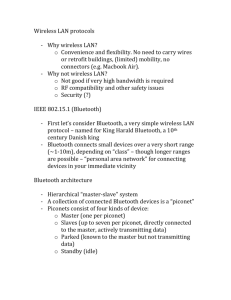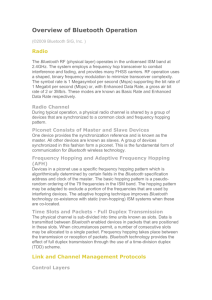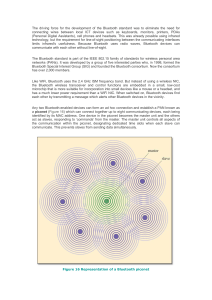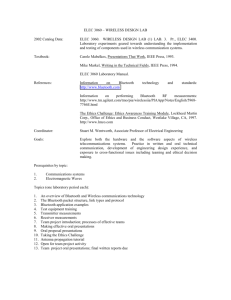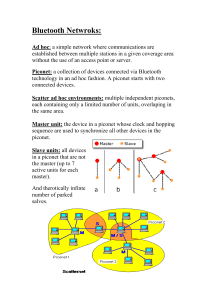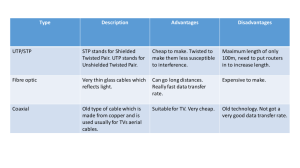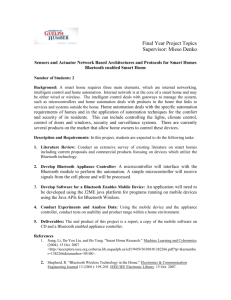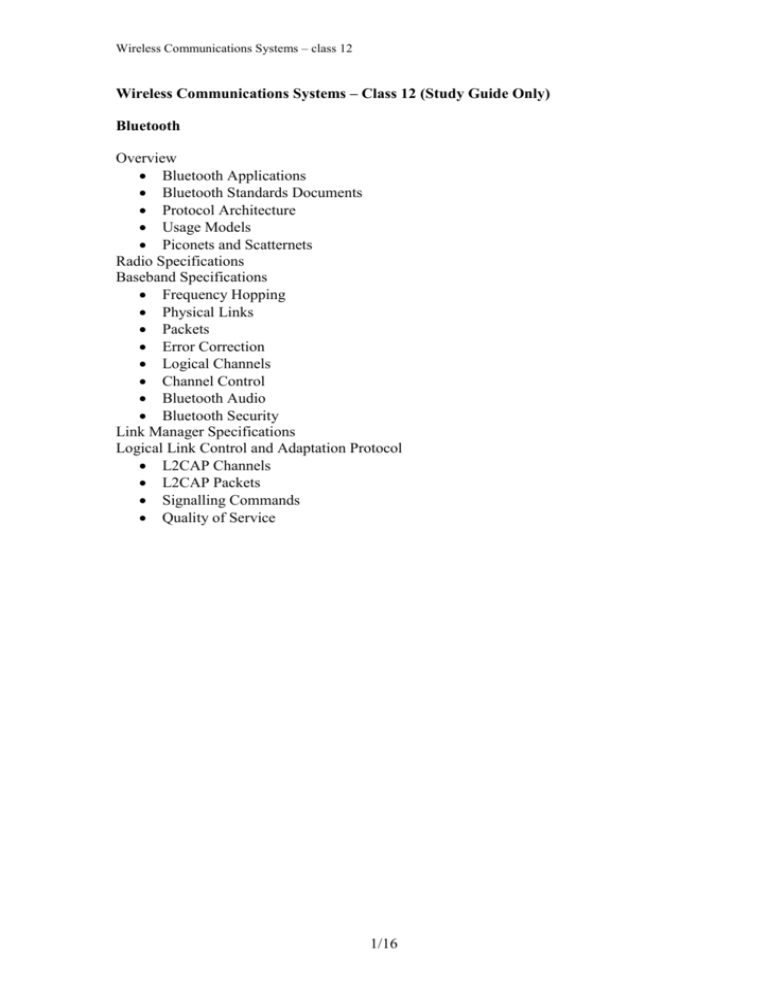
Wireless Communications Systems – class 12
Wireless Communications Systems – Class 12 (Study Guide Only)
Bluetooth
Overview
Bluetooth Applications
Bluetooth Standards Documents
Protocol Architecture
Usage Models
Piconets and Scatternets
Radio Specifications
Baseband Specifications
Frequency Hopping
Physical Links
Packets
Error Correction
Logical Channels
Channel Control
Bluetooth Audio
Bluetooth Security
Link Manager Specifications
Logical Link Control and Adaptation Protocol
L2CAP Channels
L2CAP Packets
Signalling Commands
Quality of Service
1/16
Wireless Communications Systems – class 12
Bluetooth Overview
Bluetooth is an always-on, short-range radio hook-up that resides on a microchip. It
was initially developed by Swedish mobile-phone maker Ericsson in 1994 as a way to
let laptop computers make calls over a mobile phone. Since then, several thousand
companies have signed on to make Bluetooth the low-power short-range wireless
standard for a wide range of devices.
The Bluetooth standards are published by an industry consortium known as the
Bluetooth SIG (special interest group).
The concept behind Bluetooth is to provide a universal short-range wireless
capability. It uses the 2.4-GHz band, available globally for unlicensed low-power
uses.
Bluetooth is intended to support an open-ended list of applications including data,
audio, graphics, and even video. Bluetooth can provide consumers with the ability to
do the following:
Make calls from a wireless headset connected remotely to a cell phone.
Eliminate cable linking computers to printers, keyboards, and the mouse.
Hook up MP3 players wirelessly to other machines to download music.
Set up home networks so that normal household equipment such as air
conditioning, lightning, oven controls etc. can be remotely monitored and
controlled.
Call home from a remote location to turn appliances on or off, set alarms and
monitor activity.
Bluetooth Applications
Bluetooth is designed to operate in an environment of many users. Up to eight devices
can communicate in a small network called a piconet. Ten of these piconets can
coexist in the same coverage range of the Bluetooth radio.
To provide security, each link is encoded and protected against eavesdropping and
interference.
Using short range wireless connectivity, Bluetooth can provide support for three
general applications areas:
Data and voice access point: Bluetooth facilitates real-time voice and data
transmissions by providing wireless connection of portable stationary
communications devices.
Cable Replacement: Connections are instant and are maintained even when
the devices are not within LoS. The range of each radio is approximately 10 m
but can be extended to 100 m with an optional amplifier.
Ad hoc networking: A device equipped with a Bluetooth radio can establish
instant connection to another radio as soon as it comes into range.
Other Bluetooth Application examples are:
2/16
Wireless Communications Systems – class 12
Three in one phone: Phone works as an intercom (office), fixed line (home),
or mobile (when on the move).
Internet Bridge: Use a portable PC to surf in the internet anywhere, whether
the connection is wireless through a mobile phone (mobile) or through a wired
connection (PSTN, ISDN, LAN, xDSL).
Briefcase e-mail: Notification of received e-mail message using the mobile
phone.
Automatic Synchronization: of desktop computer, portable PC, notebook
and mobile phone.
Cordless Desktop: Connect your desktop/laptop computer cordlessly to
printers, scanners, keyboard, mouse, and the LAN.
Bluetooth Standards Documents
Bluetooth standards represent a formidable bulk. There are well over 1500 pages,
divided into two groups:
Core Specifications: Describes the details of the various layers of the
Bluetooth protocol architecture, from the radio interface to link control.
Profile Specifications: Are concerned with the use of Bluetooth technology to
support various applications. Each profile specification discusses the use of the
technology defined in the core specifications to implement a particular usage
model. It includes a description of which aspects of the core specifications are
mandatory, optional, and not applicable.
Protocol Architecture
Bluetooth is defined as a layered protocol architecture consisting of core protocols,
cable replacement, telephony control protocols, and adopted protocols as shown in
Figure 1.
Figure 1: Bluetooth Protocol Stack.
3/16
Wireless Communications Systems – class 12
The core protocols form a five-layer stack consisting of the following elements:
Radio: Specifies the details of the air interface, including frequency, the use of
frequency hopping, modulation scheme, and transmit power.
Baseband: Concerned with connection establishment within a piconet,
addressing, packet format, timing, and power control.
Link Manager Protocol (LMP): Responsible for linking setup between
Bluetooth devices and ongoing link management. (this includes security
aspects such as authentication and encryption, plus the control and negotiation
of baseband packet sized).
Logical Link Control and Adaptation Protocol (L2CAP): Adapts upperlayer protocols to the baseband layer. L2CAP provides both connectionless
and connection-oriented services.
Service Discovery Protocol (SDP): Device information, services, and the
characteristics of the services can be queried to enable the establishment of a
connection between two or more Bluetooth devices.
RFCOMM is the cable replacement protocol included in the Bluetooth specification.
RFCOMM presents a virtual serial port that is designed to make a replacement of
cable technologies as transparent as possible.
RFCOMM provides for binary data transport and emulates EIA-232 control signals
over the Bluetooth baseband layer. EIA-232 (formerly known as RS-232) is a widely
used serial port interface standard.
Bluetooth specifies a telephony control protocol. TCS BIN (telephony control
specification-binary) is a bit oriented protocol that defines the call control signalling
for the establishment of speech and data calls between Bluetooth devices.
The adopted protocols are defined in specifications issued by other standards-making
organizations and incorporated into the overall Bluetooth architecture.
The Bluetooth strategy is to invent only necessary protocols and use existing
standards whenever possible. Some of the adopted protocols are:
PPP (point to point protocol)
TCP/UDP/IP
OBEX (object exchange protocol)
WAE/WAP (wireless application environment and protocol).
Usage Models
In essence, a usage model is a set of protocols that implement a particular Bluetoothbased application. Each profile defines the protocol and protocol features supporting a
particular usage model. The highest priority usage models are:
File Transfer: Supports the transfer of directories, files, documents, images,
and streaming formats. This usage model also includes the capability to
browse folders on a remote device.
4/16
Wireless Communications Systems – class 12
Internet Bridge: With this usage model, a PC is wirelessly connected to a
mobile phone or cordless modem to provide dial-up networking and fax
capabilities.
LAN access: This usage model enables devices on a piconet to access a LAN.
Synchronization: This model provides a device-to-device synchronization of
personal information management (PIM) information.
Three in one phone: Telephone handsets that implement this usage model
may act as a cordless phone connecting to a voice BS, as an intercom device
for connecting to other telephones, and as a cellular phone.
Headset: The headset can act as a remote device’s audio input and output
interface.
Piconets and Scatternets
The basic unit of networking in Bluetooth is a piconet, consisting of a master and
from one to seven active slave devices. The radio designated as the master makes the
determination of the channel (Frequency Hopping Sequence) and phase (timing offset,
i.e., when to transmit) that shall be used by all devices on this piconet.
The radio designated as master makes this determination using its own device address
as a parameter, while the slave devices must tune to the same channel and phase. A
slave may only communicate with the master and may only communicate when
granted permission by the master.
A device in one piconet may also exist as a part of another piconet and may function
as either a slave or master in each piconet as illustrated in Figure 2. This form of
overlapping is called a scatternet.
Figure 2: Master/Slave Relationship
Figure 3 shows the piconet/scatternet architecture in comparison with other forms of
wireless networks. The advantage of the piconet/scatternet scheme is that it allows
many devices to share the same physical are and make efficient use of the bandwidth.
The physical area and total bandwidth are shared by the scatternet. The logical
channel and data transfer are shared by a piconet.
5/16
Wireless Communications Systems – class 12
Figure 3: Wireless Network Configurations.
Radio Specifications
The Bluetooth radio specification is a document that gives the basic details of radio
transmission for Bluetooth devices. Table 1 summarizes the key parameters:
Parameter
Topology
Modulation
Peak data rate
RF bandwidth
RF band
RF carriers
Carrier spacing
Transmit power
Piconet access
Frequency hop rate
Scatternet access
Value
Up to 7 simultaneous links in a logical star
GFSK
1 Mbps
220 kHz (-3dB), 1 MHz (-20dB)
2.4-GHz ISM band
23/79
1 MHz
0.1 W
FH-TDD-TDMA
1600 hops/s
FH-CDMA
Table 1: Bluetooth Radio and Baseband Parameters.
Bluetooth makes use of the 2.4-GHz band within the ISM1 band. In most countries,
the bandwidth is sufficient to define 79 1-MHz physical channels. Power control is
used to keep the devices from emitting any more RF power than necessary. The power
control algorithm is implemented using the link management protocol between a
master and the slaves in a piconet.
One important aspect of the radio specifications is the definition of three classes of
transmitters based on output power:
1
Industrial Scientific and Medical
6/16
Wireless Communications Systems – class 12
Class 1: Outputs 100 mW (+20 dBm) for maximum range, with a minimum of
1 mW (0 dBm). In this class power control is mandatory, ranging from 4 to 20
dBm. This mode provides the greatest distance.
Class 2: Outputs 2.4 mW (+4 dBm) at maximum, with a minimum of 250 W
(-6 dBm). Powr control is optional.
Class 3: Lowest power. Nominal output is 1 mW.
Modulation for Bluetooth is Gaussian FSK, with a binary one represented by a
positive frequency deviation and a binary zero represented by a negative frequency
deviation from the centre frequency. The minimum deviation is 115 kHz.
The main characteristics of the receivers include the following:
Sensitivity Level: The receiver must have a sensitivity level for which the
bit error rate (BER) 0.1% is met. For Bluetooth this means an actual sensitivity
level of -70dBm or better.
Interference Performance: The interference performance on Co-channel
and adjacent 1 MHz and 2 MHz are measured with the wanted signal 10 dB
over the reference sensitivity level. On all other frequencies the wanted signal
shall be 3 dB over the reference sensitivity level.
Out-of-Band blocking: The Out of band blocking is measured with the
wanted signal 3 dB over the reference sensitivity level. The interfering signal
shall be a continuous wave signal. The BER shall be less than or equal to
0.1%.
Intermodulation Characteristics: The reference sensitivity performance,
BER = 0.1%, shall be met under the following conditions.
The wanted signal at frequency f 0 with a power level 6 dB over the
reference sensitivity level.
A static sine wave signal at f1 with a power level of –39 dBm.
A Bluetooth modulated signal at f 2 with a power level of -39 dBm.
Such that:
f 0 2 f1 f 2
and
f 2 f1 n 1 MHz,
where n can be 3, 4, or 5. The system must fulfil one of the three alternatives.
RSSI: Receiver Signal Strength Indicator (Optional): A transceiver that
wishes to take part in a power-controlled link must be able to measure its own
receiver signal strength and determine if the transmitter on the other side of the
link should increase or decrease its output power level. A Receiver Signal
Strength Indicator (RSSI) makes this possible.
The way the power control is specified is to have a golden receive power range. This
golden receive power is defined as a range with a lower and higher threshold levels
and a high limit. The lower threshold level corresponds to a received power between
7/16
Wireless Communications Systems – class 12
-56 dBm and 6 dB above the actual sensitivity of the receiver. The upper threshold
level is 20 dB above the lower threshold level to reach an accuracy of 6 dB. The
instructions to alter the TX power are carried in the LMP link
Baseband Specifications
The Baseband is the physical layer of the Bluetooth. It manages physical channels and
links apart from other services like error correction, data whitening, hop selection and
Bluetooth security.
The Baseband layer lies on top of the Bluetooth radio layer in the Bluetooth stack.
The baseband protocol is implemented as a Link Controller, which works with the
link manager for carrying out link level routines like link connection and power
control.
The baseband also manages asynchronous and synchronous links, handles packets and
does paging and inquiry to access and inquire Bluetooth devices in the area. The
baseband transceiver applies a time-division duplex (TDD) scheme. (alternate
transmit and receive). Therefore apart from different hopping frequency (frequency
division), the time is also slotted.
Frequency Hopping
Frequency hopping in Bluetooth serves two purposes:
Provides resistance to interference and multipath effects
Provides a form of multiple access among co-located devices in different
piconets.
The total bandwidth is divided into 79 physical channels, each of bandwidth 1 MHz.
FH occurs by jumping from one channel to another in a pseudorandom sequence. The
hopping sequence (PN) is shared by all of the devices on a single piconet2.
The hop rate is 1600 hops per second, so that each physical channel is occupied for a
duration of 625-s. Each of the 625-s time period is referred to as a slot, and these
are numbered sequentially.
Bluetooth radios communicate using a time division duplex discipline (TDD).
Because more than two devices share the piconet medium, the access technique is
TDMA. Thus, piconet access can be characterized as FH-TDD-TDMA.
Using TDD prevents crosstalk between the transmit and receive operations in the
radio transceiver, which is essential if a one-chip implementation is desired.
The FH sequence is determined by the master in a piconet and is a function of the
master’s Bluetooth address. Because different piconets in the same area will have
different masters, they will use different hop sequences. Thus, most of the time,
2
This will be referred to as FH channel for clarity purposes.
8/16
Wireless Communications Systems – class 12
transmission on two devices on different piconets in the same area will be on different
physical channels.
Occasionally, two piconets will use the same physical channel during the same time
slot, causing a collision and lost data. However, because this will happen infrequently,
it is readily accommodated with forward error correction and error detection/ARQ
techniques. Thus, a form of CDMA is achieved between devices on different piconets
in the same scatternet; this is referred to as FH-CDMA.
Physical Links
Two types of links can be established between a master and a slave:
Synchronous connection oriented (SCO): Allocates a fixed bandwidth
between a point-to-point connection involving the master and a single slave.
The master maintains the SCO link by using reversed slots at regular intervals.
The basic unit of reservation is two consecutive slots (one in each transmission
direction). The master can support up to three simultaneous SCO links while a
slave can support two or three SCO links. SCO packets are never
retransmitted.
Asynchronous connectionless (ACL): A point-to-multipoint link between the
master and all the slaves in the piconet. In slots not reserved for SCO links, the
master can exchange packets with any slave on a per-slot basis, including a
slave already engaged in an SCO link. Only a single ACL link can exists. For
most ACL packets, packet retransmission is applied.
Packets
The packet format for all Bluetooth packets consists of three main fields:
Access Code (72 bits): Used for timing synchronization, offset compensation,
paging and inquiry.
Header (54 bits): Used to identify packet type and to carry protocol control
information.
Payload (0 to 2745 bits): If present, contains user voice and data and, in most
cases, a payload header.
There are three types of access code:
Channel access code (CAC): Identifies the piconet (unique for a piconet).
Device access code (DAC): Used for paging and its subsequent responses
Inquiry access code(IAC): Used for inquiry purposes.
The header format for all Bluetooth packets consists of six fields:
3
AM_ADDR(3 bits): Contains the “active mode” address3 of one of the slaves
(there are at most seven devices in a piconet). A transmission from the master
to a slave contains that slave’s address; a transmission from a slave contains it
Temporary address assigned to this slave in this piconet.
9/16
Wireless Communications Systems – class 12
address. The 0 value is reserved for a broadcast from the master to all slaves in
the piconet.
Type: Identifies the type of packed. Four type codes are reserved for control
packets common to both SCO and ACL links. The remaining packet types are
used to convey user information.
Flow: Provides a 1-bit flow control mechanism for ACL traffic only. When a
packet with Flow = 0 is received, the station receiving the packet must
temporarily halt the transmission of ACL packets on this link. When a packet
with Flow = 1 is received, transmission may resume.
ARQN: Provides 1-bit acknowledgement mechanism for ACL traffic
protected by a CRC. If the reception was successful, an ACK (ARQN = 1) is
returned; otherwise a NAK (ARQN = 0) is returned. When no return message
regarding acknowledge is received, a NAK is assumed implicitly. If a NAK is
received, the relevant packet is retransmitted.
Header error control (HEC): An 8-bit error detection code used to protect
the packet header.
Payload Format:
For some packet types, the baseband specification defines a format for the payload
field. For voice payloads, no header is defined. For all of the ACL packets and for the
data portion of the SCO packet, a header is defined. For data payloads, the payload
format consists of three fields:
Payload header: An 8-bit header is defined for a single-slot packet, and a 16bit header is defined for a multi-slot packet.
Payload body: Contains user information
CRC: A 16-bit CRC code is used on all data payloads except the AUX1
packet (which carries 30 information bytes with no CRC or FEC which is
typically used for high-speed data.4)
The payload header, when present consists of three fields:
L_CH: Identifies the logical channel.
Flow: Used to control flow at the L2CAP level. (This is the same on/off
mechanism provided by the flow field in the packet header for ACL traffic).
Length: The number of bytes of data in the payload, excluding the payload
header and CRC.
Error Correction
Bluetooth makes use of three error correction schemes:
4
1/3 rate FEC
2/3 rate FEC
ARQ
Check Stallings Pg 497, Table 15.5
10/16
Wireless Communications Systems – class 12
These error correction schemes are designed to satisfy competing requirements. The
error correction scheme must be adequate to cope with the inherently unreliable
wireless link but must also be streamlined and efficient.
Logical Channels
Bluetooth defines five types of logical data channels designed to carry different types
of payload traffic.
Link Control (LC): Used to manage the flow of packets over the link
interface. The LC channel is mapped onto the packet header. This channel
carries low-level link control information like ARQ, flow control, and payload
characterization.
Link Manager (LM): Transports link management information between
participating stations.
User asynchronous (UA): Carries asynchronous user data.
User isochronous (UI): Carries isochronous5 user data.
User synchronous (US): Carries synchronous user data.
Channel Control
The operation of a piconet can be understood in terms of the states of operation during
link establishment and maintenance (Figure 4). There are two major states:
Standby: The default state. This is a low-power state in which only the native
clock is running.
Connection: The device is connected to a piconet as a master or a slave.
Figure 4: Bluetooth state transition diagram.
5
The term isochronous refers to blocks of data that recur with known periodic time.
11/16
Wireless Communications Systems – class 12
In addition, there are seven interim sub-states that are used to add new slaves to a
piconet. To move from one state to the other, either commands from the Bluetooth
link manager or internal signals in the link controller are used. The sub-states are as
follows:
Page: Used by the master to activate and connect to a slave. Uses the slave
device access code (DAC)
Page scan: Device is listening for a page with its own DAC.
Master response: A device acting as a master receives a page response from a
slave. The device can now enter the connection state or return to the page state
to page for other slaves.
Slave response: A device acting as a slave responds to a page from a master.
If connection setup succeeds, the device enters the connection state; otherwise
it returns to the page scan state.
Inquiry: Device has issued an inquiry, to find the identity of the devices
within range.
Inquiry scan: Device is listening for an enquiry
Inquiry response: A device that has issued an inquiry receives an inquiry
response.
Bluetooth Audio
The baseband specifications indicate that either of two voice encoding schemes can be
used:
Pulse Code Modulation (PCM)
Continuously Variable Slope Delta (CVSD)
Bluetooth Security
The Bluetooth baseband specifications defines a facility for link security between any
two Bluetooth devices, consisting of the following elements:
Authentication.
Encryption (Privacy).
Key management and usage.
The security algorithms make use of four parameters:
Unit address: The 48-bit device address, which is publicly known.
Secret authentication key: A secret 128-bit key
Secret privacy key: A secret key of length from 4 to 128 bits
Random number: A 128-bit random number derived from a pseudorandom
generation algorithm executed in the Bluetooth unit.
The two secret keys are generated and configured with the unit and not disclosed. The
purpose of authentication is to verify the claimed identity of one of the two
Bluetooth devices involved in an exchange. User information can be protected by
encryption of the packet payload.
12/16
Wireless Communications Systems – class 12
Link Manager Specifications
The Link Manager carries out link setup, authentication, link configuration and other
protocols. It discovers other remote LM’s and communicates with them via the Link
Manager Protocol (LMP). To perform its service provider role, the LM uses the
services of the underlying Link Controller (LC).
The Link Manager Protocol essentially consists of a number of PDU (protocol Data
Units), which are sent from one device to another. LM PDUs are always sent as
single-slot packets and the payload header is therefore one byte.
The procedures defined for LMP are grouped into 24 functional areas, each of which
involves the exchange of one or more messages. Table 2 lists these areas, together
with the PDUs involved in each area.
Function
General response
Authentication
Pairing
Change link key
Change current link key
Clock offset request
Slot offset information
Timing accuracy
Information request
LMP version
Supported features
Switch master/slave role
Name request
Detach
Hold mode
Sniff mode
Park mode
Power control
Channel quality-driven
Change between DM and DH
Quality of service
SCO links
Control of multi-slot packet
Paging scheme
Link supervision
PDU’s
Accepted, not_accepted
Security Service
au_rand, sres
in_rand, au_rand, sres, comb_key, unit_key
comb_key
temp_rand, temp_key, use_semi_permanent_key
Time/synchronization
clkoffset_req, clkoffset_res
slot_offset
timing_accuracy_req,
timing_accuracy_res
Station Capability
version_req, version_res
features_req, features_res
Mode Control
switch_req
name_req, name_res
detach
hold, hold_req
sniff, sniff_req, sniff_res
park_req, park_set, set_broadcast_window,
modify_beacon, unpark_PM_ADDR_req,
unpark_BD_ADDR_req
incr_power_req, decr_power_req, max_power,
min_power
auto_rate, preferred_rate
quality_of_service, quality_of_service_req
SCO_link_req, remove_ SCO_link_req
max_slot, max_slot_req
page_mode_req, page_scan_mode_req
supervision_timeout.
Table 2: LMP PDU’s.
13/16
Wireless Communications Systems – class 12
Logical Link Control and Adaptation Protocol (L2CAP)
In the IEEE 802 specification, L2CAP provides a link layer protocol between entities
across a shared-medium network. It also provides a number of services and relies on
the baseband layer for flow and error control.
L2CAP makes use of ACL links; it does not provide support for SCO links. L2CAP
provides 2 alternatives of service to upper-layer protocols using ACL links:
Connectionless service: This is a reliable datagram style of service.
Connection-mode service: This is similar to the service offered by HDLC. A
logical connection is set up between two users exchanging data. Flow and
error control are provided.
L2CAP provides three types of logical channels:
Connectionless: Supports the connectionless service. Each channel is
unidirectional and is used for broadcast from the master to multiple slaves.
Connection-oriented: Supports connection oriented service. Each channel is
full duplex. A quality of service flow specification is assigned in each
direction.
Signalling: Provides fro the exchange of signalling messages between L2CAP
entities.
L2CAP Packets
Figure 5 shows the format of L2CAP packets:
Figure 5: L2CAP Packet Format. (a) Connectionless PDU. (b) Connection-oriented PDU. (c)
Signalling command PDU. (d) Command Format.
In the connectionless PDU, the following fields are used:
14/16
Wireless Communications Systems – class 12
Length: Length of the information payload plus PSM fields in bytes
Channel ID: A value of 2 indicating the connectionless channel.
Protocol/Service multiplexer (PSM): Identifies the higher layer recipient for
the payload in this packet.
Information payload: Higher layer user data. This field may be up to 65533
bytes in length.
Connection oriented packets have the same format as connectionless packets, but
without the PSM field. The PSM field is not needed because the CID identifies the
upper layer recipient of the data. The information payload field may be up to 65535
bytes is length.
Signalling commands packets have the same header format as the connection-oriented
packets. In this case the CID value is 1, indicating the signalling channel. The payload
of a signalling packet consists of one or more L2CAP commands, each of which
consists of four fields:
Code: Identifies the type of command
Identifier: Used to match a request with its reply. The requesting device sets
this field and the responding device uses the same value in its response. A
different identifier must be used for each original command.
Length: Length of the data field for this command in bytes
Data: Additional data, if necessary, relating to this command.
Signalling Commands
There are eleven commands in five categories (Table 3). The command reject
command can be sent in response to any command to reject it. Reasons for rejection
include invalid CID or length exceeded.
Connection Commands: Used to establish a new logical connection.
Configure Commands: Are sent to establish an initial logical link
transmission contract between two L2CAP entities and to renegotiate this
contract whenever appropriate
Disconnection Commands: Are used to terminate a logical channel
Echo commands: Are used to solicit a response from a remote L2CAP entity.
These commands are typically used for testing the link or passing vendorspecific information using the optional data field.
Information Commands: Are used to solicit implementation-specific
information from a remote L2CAP entity.
15/16
Wireless Communications Systems – class 12
Code
0x01
0x02
0x03
0x04
0x05
0x06
0x07
0x08
0x09
0x0A
0x0B
Description
Command reject
Connection request
Connection response
Configure request
Configure response
Disconnection request
Disconnection response
Echo request
Echo response
Information request
Information response
Parameters
Reason
PSM, Source CID
Destination CID, Source CID, Result, Status
Destination CID, Flags, Options
Source CID, Flags, Results, Options
Destination CID, Source CID
Destination CID, Source CID
Data (optional)
Data (optional)
Info Type
Info Type, Result, Data (optional)
Table 3: L2CAP signalling command codes.
Quality of Service (QoS)
The QoS parameter in L2CAP defines a traffic flow specification based on RFC
1363.6 In essence, a flow specification is a set of parameters that indicate a
performance level that the transmitter will attempt to achieve.
The flow specification consists of the following parameter:
Service type: This parameter indicates the level of service for this flow. A
value of 0 indicates that no traffic will be transmitted on this channel. A value
of 1 indicates a best effort service. The device will transmit data as quick as
possible with no guarantees about performance. A value of 2 indicates a
guaranteed service (The sender will transmit data that conform to the
remaining QoS parameters).
Token rate (bytes/second): See below (bucket size)
Token bucket size (bytes): This parameter, along with the Token rate
parameter defines a token bucket scheme that is often used in QoS
specifications. The advantage of this scheme is that it provides a concise
description of the peak average traffic load the recipient can expect.
Peak bandwidth (bytes/second): Limits how fast packets may be sent backto-back from applications.
Latency (microseconds): Is the maximum acceptable delay between
transmission of a bit by the sender and its initial transmission over the air.
Delay variation (microseconds): is the difference between the maximum and
minimum possible delay that a packet will experience.
All Materials in this document where extracted and summarized from:
Source:
Stallings, W (2005) Wireless Communications and Networks, 2nd Ed., Pearson
Prentice Hall, ISBN: 0-13-196790-8
Compiled and typed by: Dr. Jose A. Santos – January 2003.
6
A proposed flow specification, RFC 1363, September 1992.
16/16


